MAT9004 Assignment 2: Linear Systems, Eigenvalues, and Relations
VerifiedAdded on 2022/11/13
|17
|913
|460
Homework Assignment
AI Summary
This document presents a detailed solution to a mathematics assignment (MAT9004) focusing on several key areas. The assignment begins with a problem on energy consumption, modeling daily energy use with a polynomial function and requiring the student to write and solve a linear system of equations based on given properties, including the function's behavior at specific times and its total energy consumption. The solution then delves into eigenvalues and eigenvectors, including finding eigenvalues, eigenvectors, and diagonalizing matrices. Finally, the assignment explores binary relations, including plotting inequalities and analyzing multivariate functions and partial derivatives. The student demonstrates proficiency in applying mathematical concepts to solve complex problems and interpret results, providing a comprehensive analysis of each problem and its solution.

Mathematics Assignment
Student Name:
Instructor Name:
Course Number:
14th July 2019
Student Name:
Instructor Name:
Course Number:
14th July 2019
Paraphrase This Document
Need a fresh take? Get an instant paraphrase of this document with our AI Paraphraser
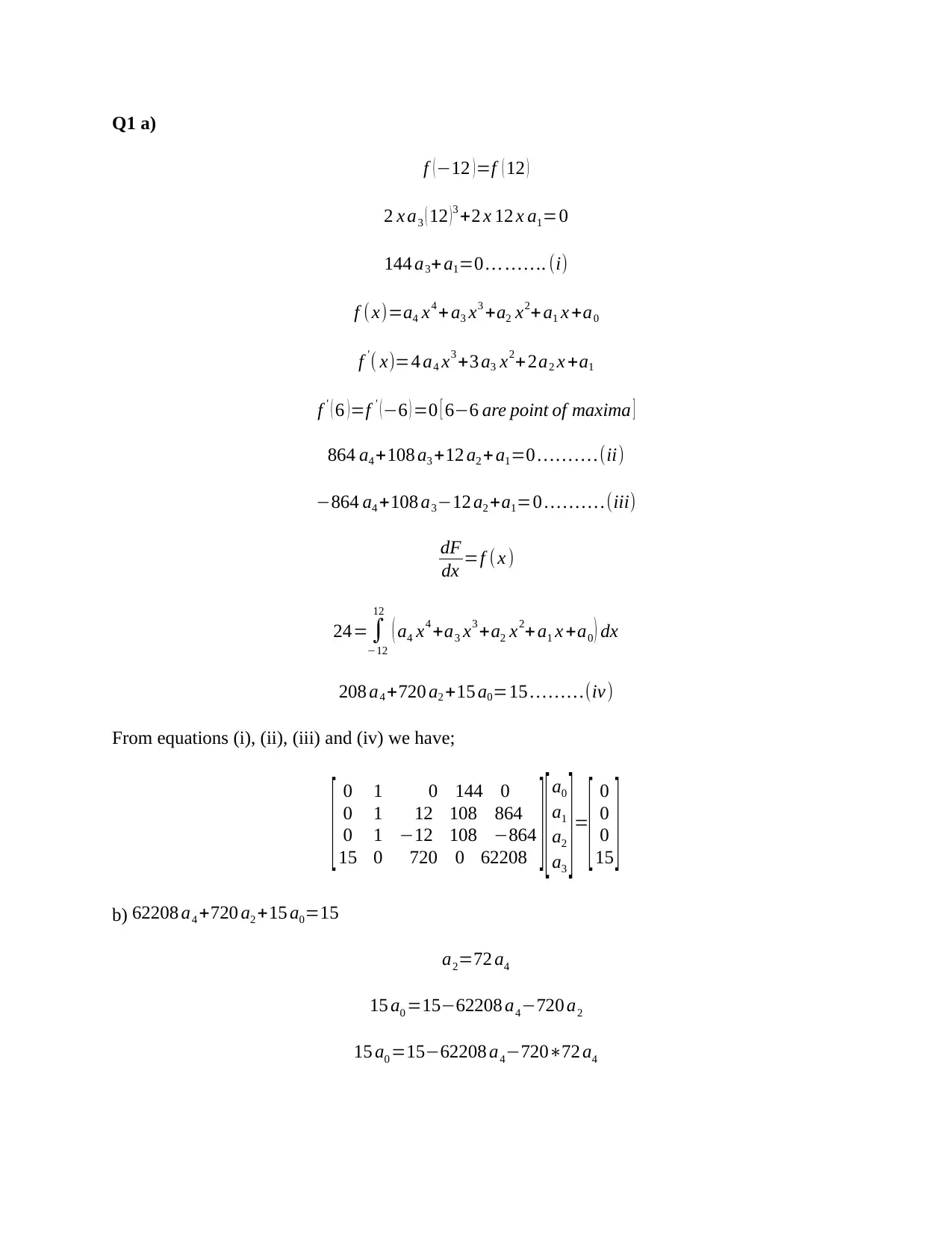
Q1 a)
f (−12 )=f ( 12 )
2 x a3 ( 12 )3 +2 x 12 x a1=0
144 a3+ a1=0 … … …. (i)
f ( x)=a4 x4 + a3 x3 +a2 x2+ a1 x +a0
f ' ( x)=4 a4 x3 +3 a3 x2+ 2a2 x +a1
f ' ( 6 )=f ' (−6 ) =0 [ 6−6 are point of maxima ]
864 a4 +108 a3 +12 a2 + a1=0 … … … .(ii)
−864 a4 +108 a3−12 a2 +a1=0 … … … .(iii)
dF
dx =f (x )
24= ∫
−12
12
( a4 x4 +a3 x3 +a2 x2+a1 x +a0 ) dx
208 a4 +720 a2 +15 a0=15 … … …(iv)
From equations (i), (ii), (iii) and (iv) we have;
[ 0 1 0 144 0
0 1 12 108 864
0
15
1
0
−12 108 −864
720 0 62208 ] [a0
a1
a2
a3
]=
[ 0
0
0
15 ]
b) 62208 a4 +720 a2 +15 a0=15
a2=72 a4
15 a0 =15−62208 a4−720 a2
15 a0 =15−62208 a4−720∗72 a4
f (−12 )=f ( 12 )
2 x a3 ( 12 )3 +2 x 12 x a1=0
144 a3+ a1=0 … … …. (i)
f ( x)=a4 x4 + a3 x3 +a2 x2+ a1 x +a0
f ' ( x)=4 a4 x3 +3 a3 x2+ 2a2 x +a1
f ' ( 6 )=f ' (−6 ) =0 [ 6−6 are point of maxima ]
864 a4 +108 a3 +12 a2 + a1=0 … … … .(ii)
−864 a4 +108 a3−12 a2 +a1=0 … … … .(iii)
dF
dx =f (x )
24= ∫
−12
12
( a4 x4 +a3 x3 +a2 x2+a1 x +a0 ) dx
208 a4 +720 a2 +15 a0=15 … … …(iv)
From equations (i), (ii), (iii) and (iv) we have;
[ 0 1 0 144 0
0 1 12 108 864
0
15
1
0
−12 108 −864
720 0 62208 ] [a0
a1
a2
a3
]=
[ 0
0
0
15 ]
b) 62208 a4 +720 a2 +15 a0=15
a2=72 a4
15 a0 =15−62208 a4−720 a2
15 a0 =15−62208 a4−720∗72 a4
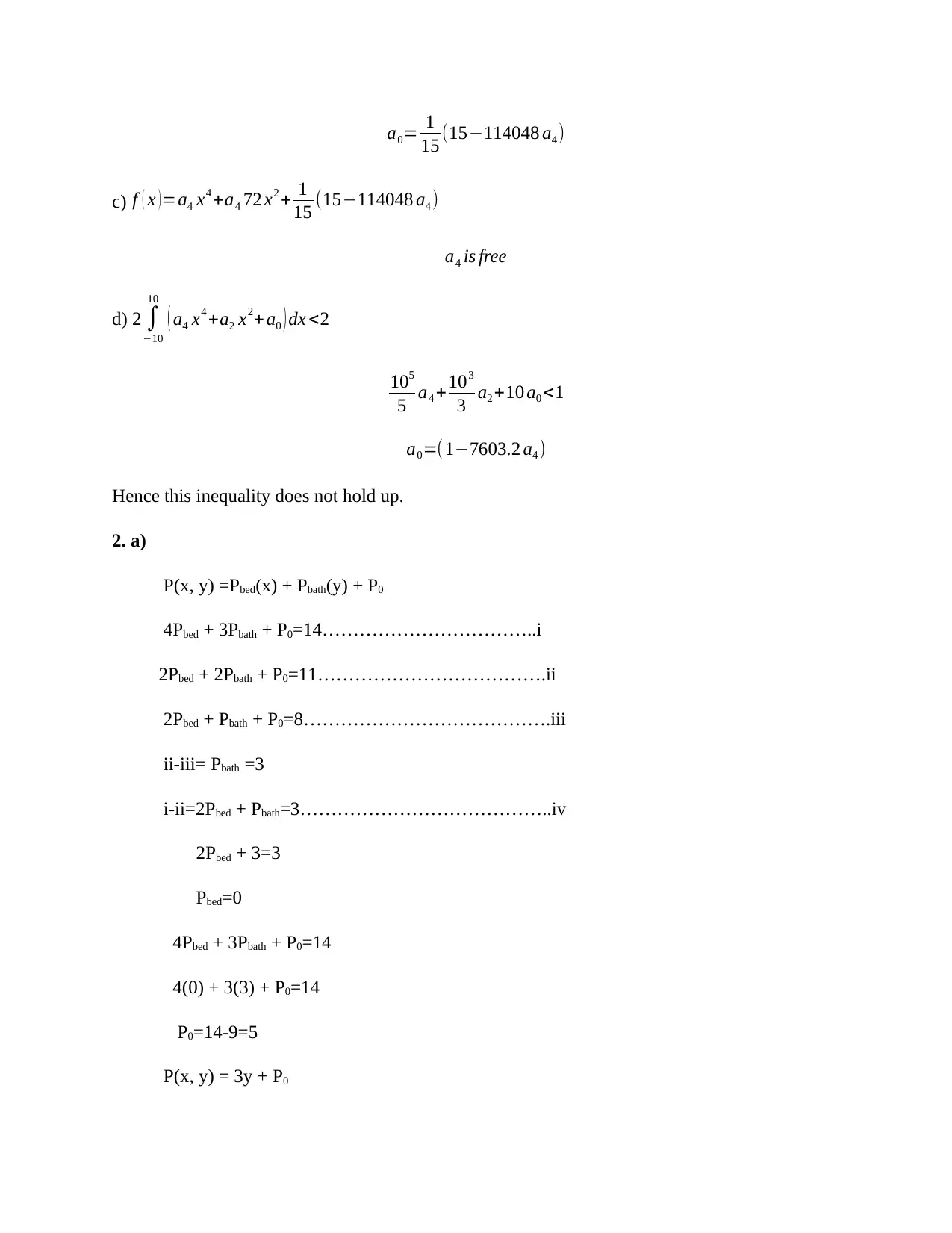
a0= 1
15 (15−114048 a4 )
c) f ( x )=a4 x4 +a4 72 x2 + 1
15 (15−114048 a4 )
a4 is free
d) 2 ∫
−10
10
( a4 x4 +a2 x2+ a0 ) dx <2
105
5 a4 +103
3 a2 +10 a0 <1
a0=(1−7603.2 a4 )
Hence this inequality does not hold up.
2. a)
P(x, y) =Pbed(x) + Pbath(y) + P0
4Pbed + 3Pbath + P0=14……………………………..i
2Pbed + 2Pbath + P0=11……………………………….ii
2Pbed + Pbath + P0=8………………………………….iii
ii-iii= Pbath =3
i-ii=2Pbed + Pbath=3…………………………………..iv
2Pbed + 3=3
Pbed=0
4Pbed + 3Pbath + P0=14
4(0) + 3(3) + P0=14
P0=14-9=5
P(x, y) = 3y + P0
15 (15−114048 a4 )
c) f ( x )=a4 x4 +a4 72 x2 + 1
15 (15−114048 a4 )
a4 is free
d) 2 ∫
−10
10
( a4 x4 +a2 x2+ a0 ) dx <2
105
5 a4 +103
3 a2 +10 a0 <1
a0=(1−7603.2 a4 )
Hence this inequality does not hold up.
2. a)
P(x, y) =Pbed(x) + Pbath(y) + P0
4Pbed + 3Pbath + P0=14……………………………..i
2Pbed + 2Pbath + P0=11……………………………….ii
2Pbed + Pbath + P0=8………………………………….iii
ii-iii= Pbath =3
i-ii=2Pbed + Pbath=3…………………………………..iv
2Pbed + 3=3
Pbed=0
4Pbed + 3Pbath + P0=14
4(0) + 3(3) + P0=14
P0=14-9=5
P(x, y) = 3y + P0
⊘ This is a preview!⊘
Do you want full access?
Subscribe today to unlock all pages.

Trusted by 1+ million students worldwide
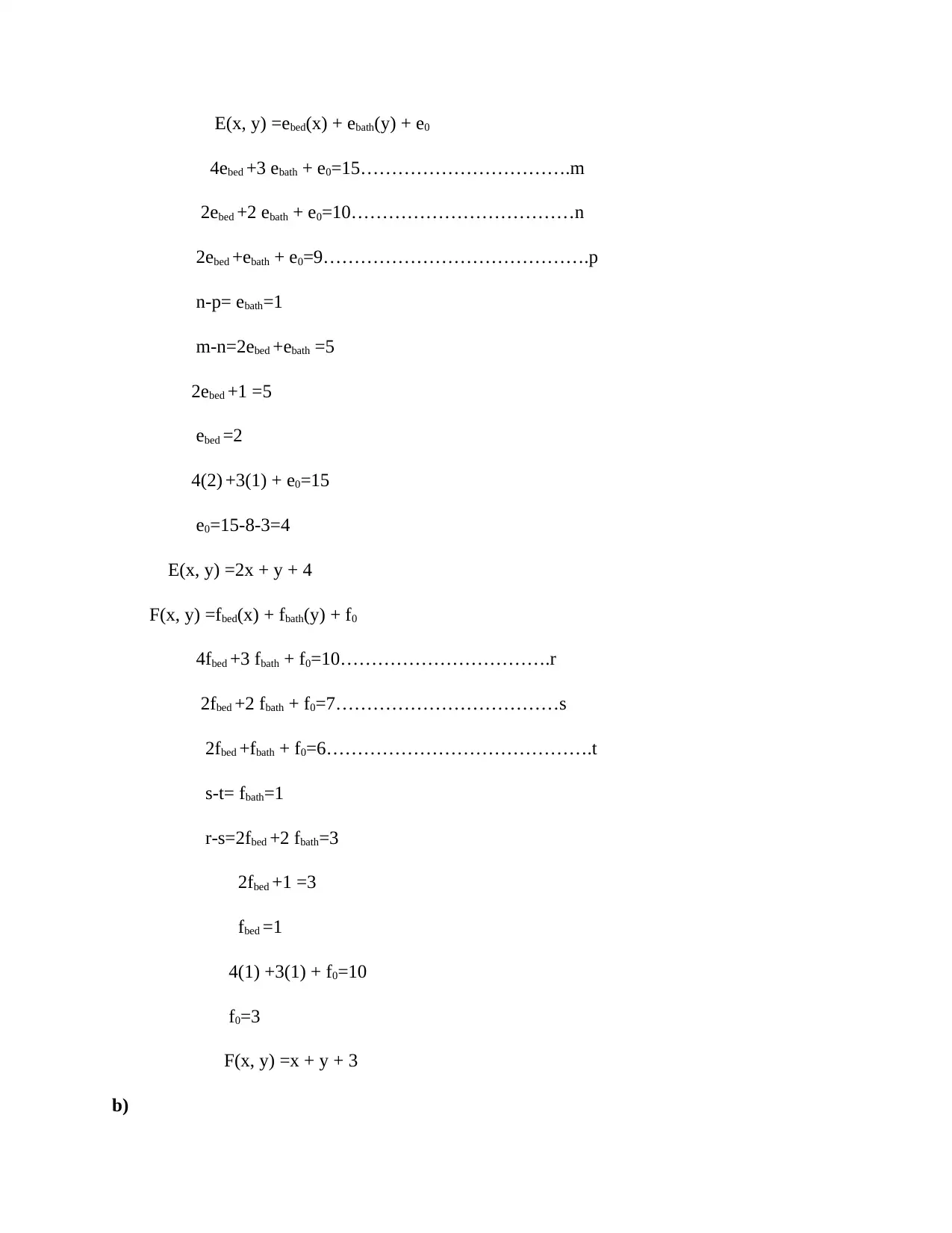
E(x, y) =ebed(x) + ebath(y) + e0
4ebed +3 ebath + e0=15…………………………….m
2ebed +2 ebath + e0=10………………………………n
2ebed +ebath + e0=9…………………………………….p
n-p= ebath=1
m-n=2ebed +ebath =5
2ebed +1 =5
ebed =2
4(2) +3(1) + e0=15
e0=15-8-3=4
E(x, y) =2x + y + 4
F(x, y) =fbed(x) + fbath(y) + f0
4fbed +3 fbath + f0=10…………………………….r
2fbed +2 fbath + f0=7………………………………s
2fbed +fbath + f0=6…………………………………….t
s-t= fbath=1
r-s=2fbed +2 fbath=3
2fbed +1 =3
fbed =1
4(1) +3(1) + f0=10
f0=3
F(x, y) =x + y + 3
b)
4ebed +3 ebath + e0=15…………………………….m
2ebed +2 ebath + e0=10………………………………n
2ebed +ebath + e0=9…………………………………….p
n-p= ebath=1
m-n=2ebed +ebath =5
2ebed +1 =5
ebed =2
4(2) +3(1) + e0=15
e0=15-8-3=4
E(x, y) =2x + y + 4
F(x, y) =fbed(x) + fbath(y) + f0
4fbed +3 fbath + f0=10…………………………….r
2fbed +2 fbath + f0=7………………………………s
2fbed +fbath + f0=6…………………………………….t
s-t= fbath=1
r-s=2fbed +2 fbath=3
2fbed +1 =3
fbed =1
4(1) +3(1) + f0=10
f0=3
F(x, y) =x + y + 3
b)
Paraphrase This Document
Need a fresh take? Get an instant paraphrase of this document with our AI Paraphraser
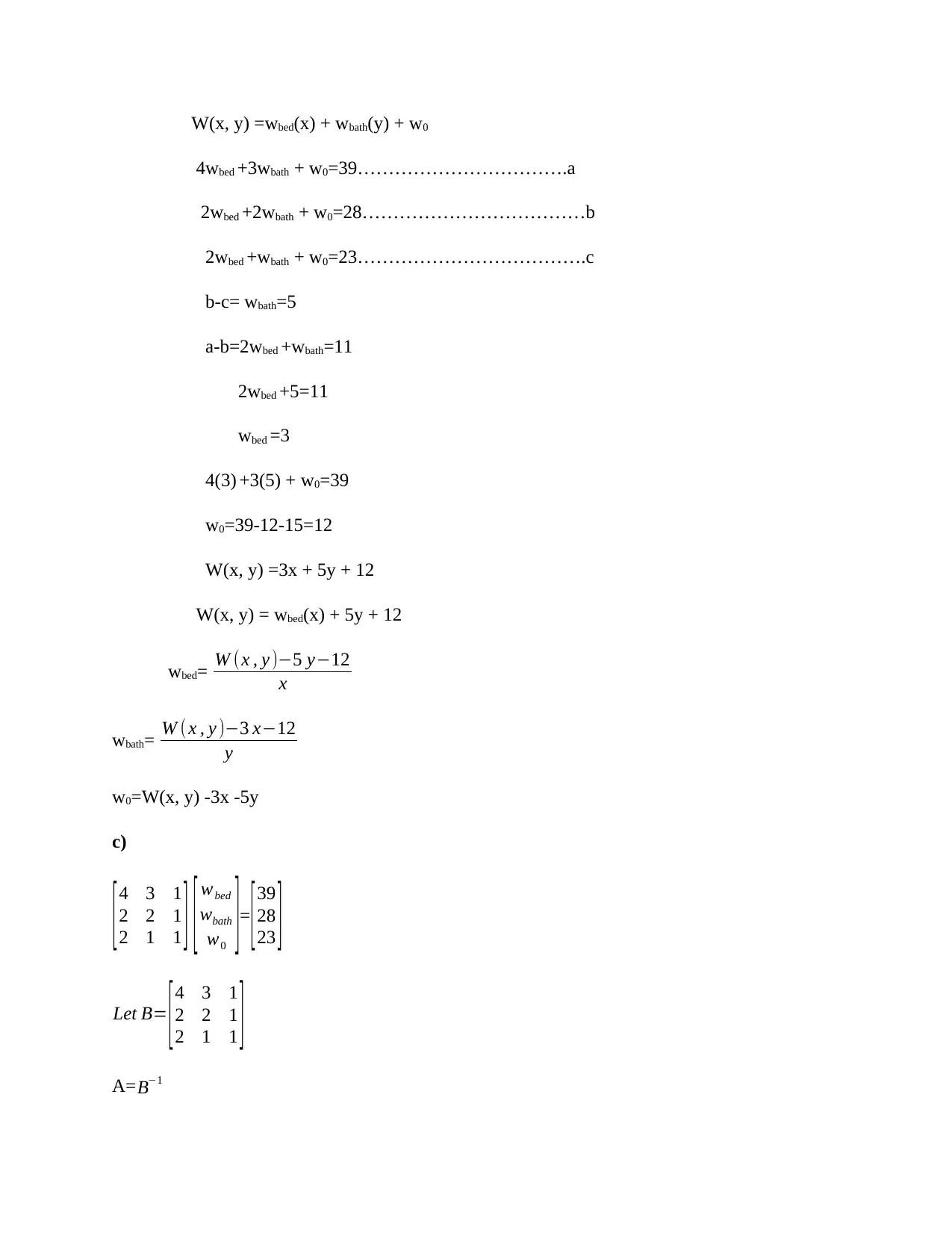
W(x, y) =wbed(x) + wbath(y) + w0
4wbed +3wbath + w0=39…………………………….a
2wbed +2wbath + w0=28………………………………b
2wbed +wbath + w0=23……………………………….c
b-c= wbath=5
a-b=2wbed +wbath=11
2wbed +5=11
wbed =3
4(3) +3(5) + w0=39
w0=39-12-15=12
W(x, y) =3x + 5y + 12
W(x, y) = wbed(x) + 5y + 12
wbed= W (x , y )−5 y−12
x
wbath= W (x , y )−3 x−12
y
w0=W(x, y) -3x -5y
c)
[4 3 1
2 2 1
2 1 1 ] [ wbed
wbath
w0 ]=
[39
28
23 ]
Let B= [4 3 1
2 2 1
2 1 1 ]
A=B−1
4wbed +3wbath + w0=39…………………………….a
2wbed +2wbath + w0=28………………………………b
2wbed +wbath + w0=23……………………………….c
b-c= wbath=5
a-b=2wbed +wbath=11
2wbed +5=11
wbed =3
4(3) +3(5) + w0=39
w0=39-12-15=12
W(x, y) =3x + 5y + 12
W(x, y) = wbed(x) + 5y + 12
wbed= W (x , y )−5 y−12
x
wbath= W (x , y )−3 x−12
y
w0=W(x, y) -3x -5y
c)
[4 3 1
2 2 1
2 1 1 ] [ wbed
wbath
w0 ]=
[39
28
23 ]
Let B= [4 3 1
2 2 1
2 1 1 ]
A=B−1
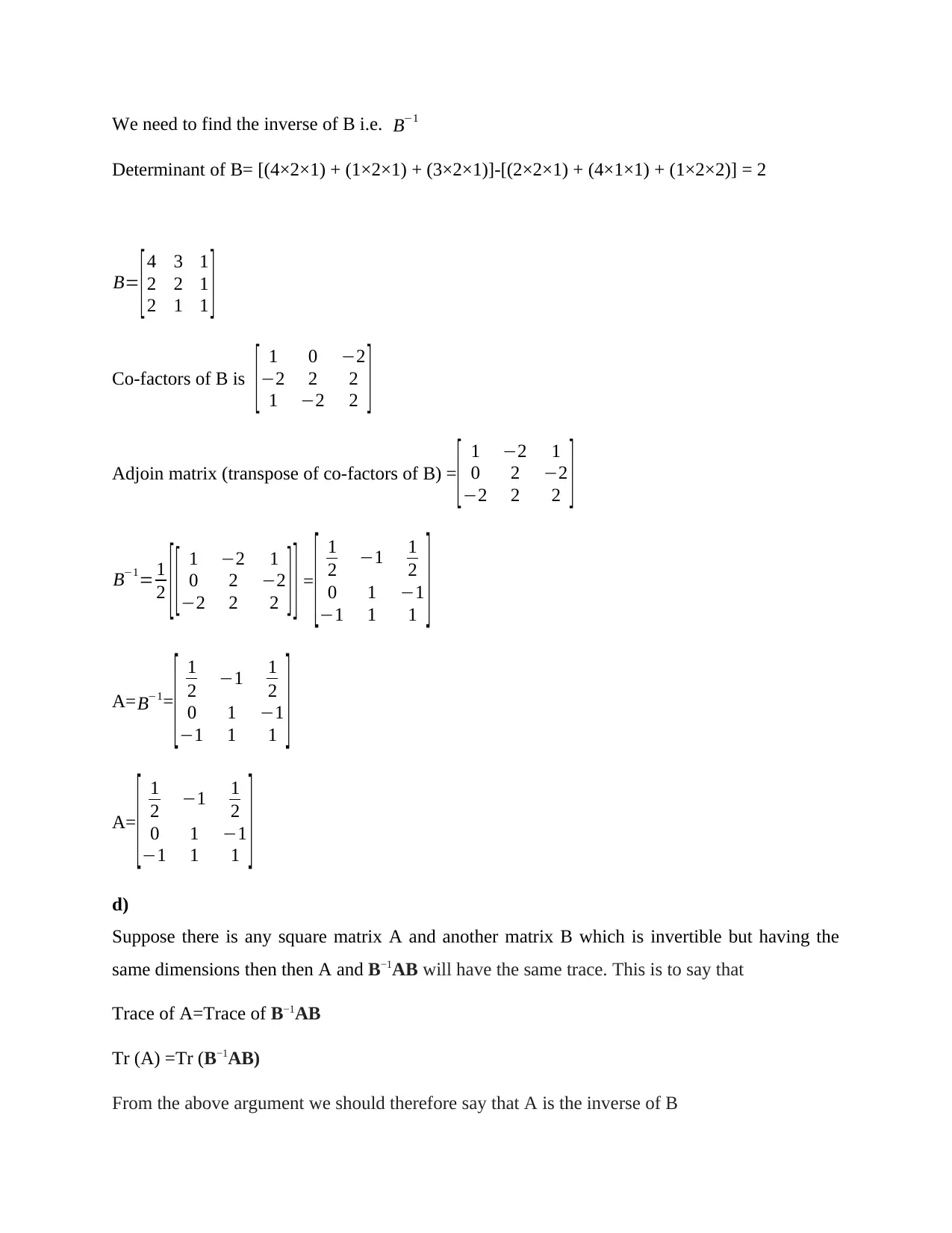
We need to find the inverse of B i.e. B−1
Determinant of B= [(4×2×1) + (1×2×1) + (3×2×1)]-[(2×2×1) + (4×1×1) + (1×2×2)] = 2
B= [4 3 1
2 2 1
2 1 1 ]
Co-factors of B is [ 1 0 −2
−2 2 2
1 −2 2 ]
Adjoin matrix (transpose of co-factors of B) = [ 1 −2 1
0 2 −2
−2 2 2 ]
B−1= 1
2 [ [ 1 −2 1
0 2 −2
−2 2 2 ] ] =
[ 1
2 −1 1
2
0 1 −1
−1 1 1 ]
A=B−1=
[ 1
2 −1 1
2
0 1 −1
−1 1 1 ]
A=
[ 1
2 −1 1
2
0 1 −1
−1 1 1 ]
d)
Suppose there is any square matrix A and another matrix B which is invertible but having the
same dimensions then then A and B−1AB will have the same trace. This is to say that
Trace of A=Trace of B−1AB
Tr (A) =Tr (B−1AB)
From the above argument we should therefore say that A is the inverse of B
Determinant of B= [(4×2×1) + (1×2×1) + (3×2×1)]-[(2×2×1) + (4×1×1) + (1×2×2)] = 2
B= [4 3 1
2 2 1
2 1 1 ]
Co-factors of B is [ 1 0 −2
−2 2 2
1 −2 2 ]
Adjoin matrix (transpose of co-factors of B) = [ 1 −2 1
0 2 −2
−2 2 2 ]
B−1= 1
2 [ [ 1 −2 1
0 2 −2
−2 2 2 ] ] =
[ 1
2 −1 1
2
0 1 −1
−1 1 1 ]
A=B−1=
[ 1
2 −1 1
2
0 1 −1
−1 1 1 ]
A=
[ 1
2 −1 1
2
0 1 −1
−1 1 1 ]
d)
Suppose there is any square matrix A and another matrix B which is invertible but having the
same dimensions then then A and B−1AB will have the same trace. This is to say that
Trace of A=Trace of B−1AB
Tr (A) =Tr (B−1AB)
From the above argument we should therefore say that A is the inverse of B
⊘ This is a preview!⊘
Do you want full access?
Subscribe today to unlock all pages.

Trusted by 1+ million students worldwide
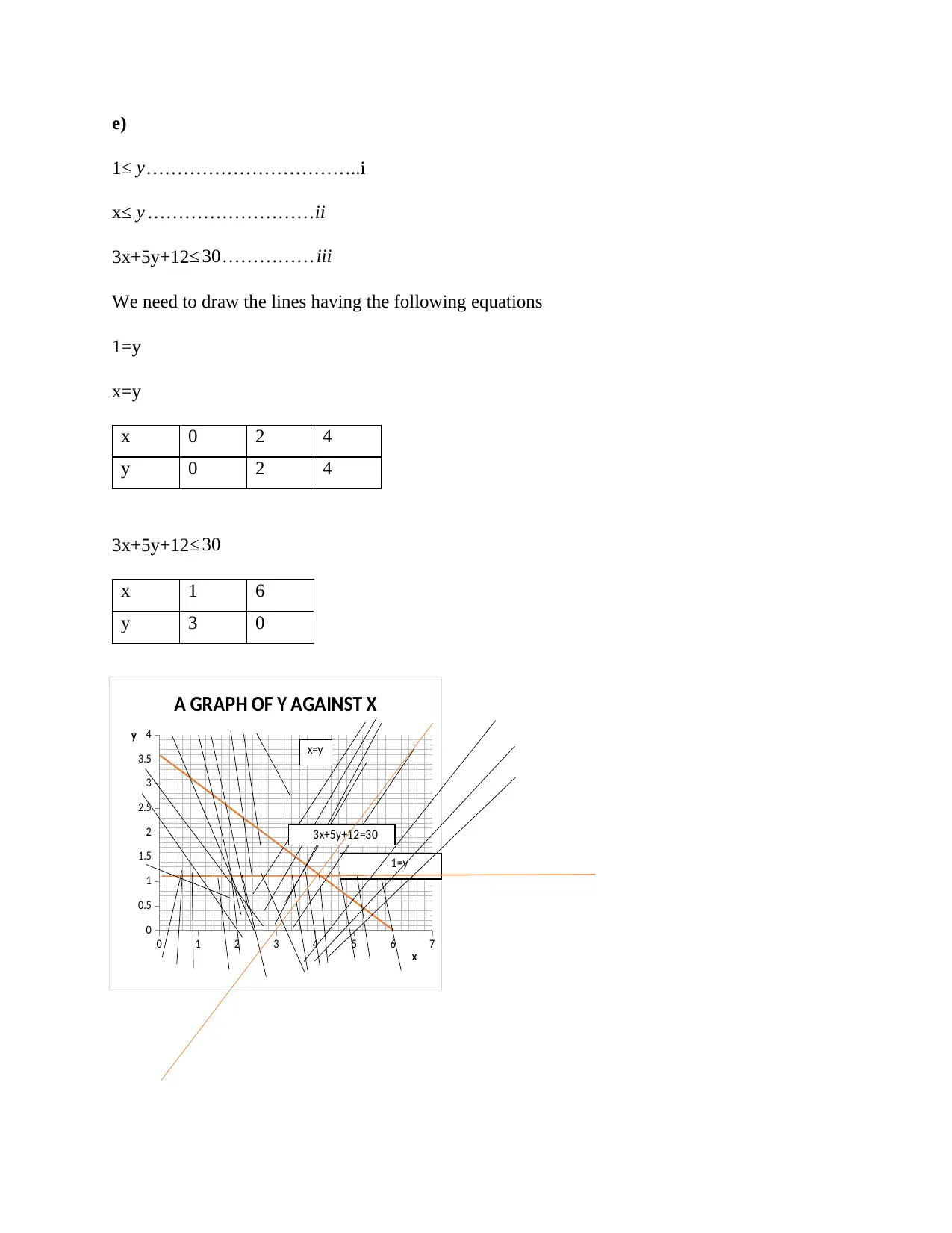
e)
1≤ y……………………………..i
x≤ y … … … … … … … … …ii
3x+5y+12≤ 30 … … …… … iii
We need to draw the lines having the following equations
1=y
x=y
x 0 2 4
y 0 2 4
3x+5y+12≤ 30
x 1 6
y 3 0
0 1 2 3 4 5 6 7
0
0.5
1
1.5
2
2.5
3
3.5
4
A GRAPH OF Y AGAINST X
x
y
1=y
3x+5y+12=30
x=y
1≤ y……………………………..i
x≤ y … … … … … … … … …ii
3x+5y+12≤ 30 … … …… … iii
We need to draw the lines having the following equations
1=y
x=y
x 0 2 4
y 0 2 4
3x+5y+12≤ 30
x 1 6
y 3 0
0 1 2 3 4 5 6 7
0
0.5
1
1.5
2
2.5
3
3.5
4
A GRAPH OF Y AGAINST X
x
y
1=y
3x+5y+12=30
x=y
Paraphrase This Document
Need a fresh take? Get an instant paraphrase of this document with our AI Paraphraser
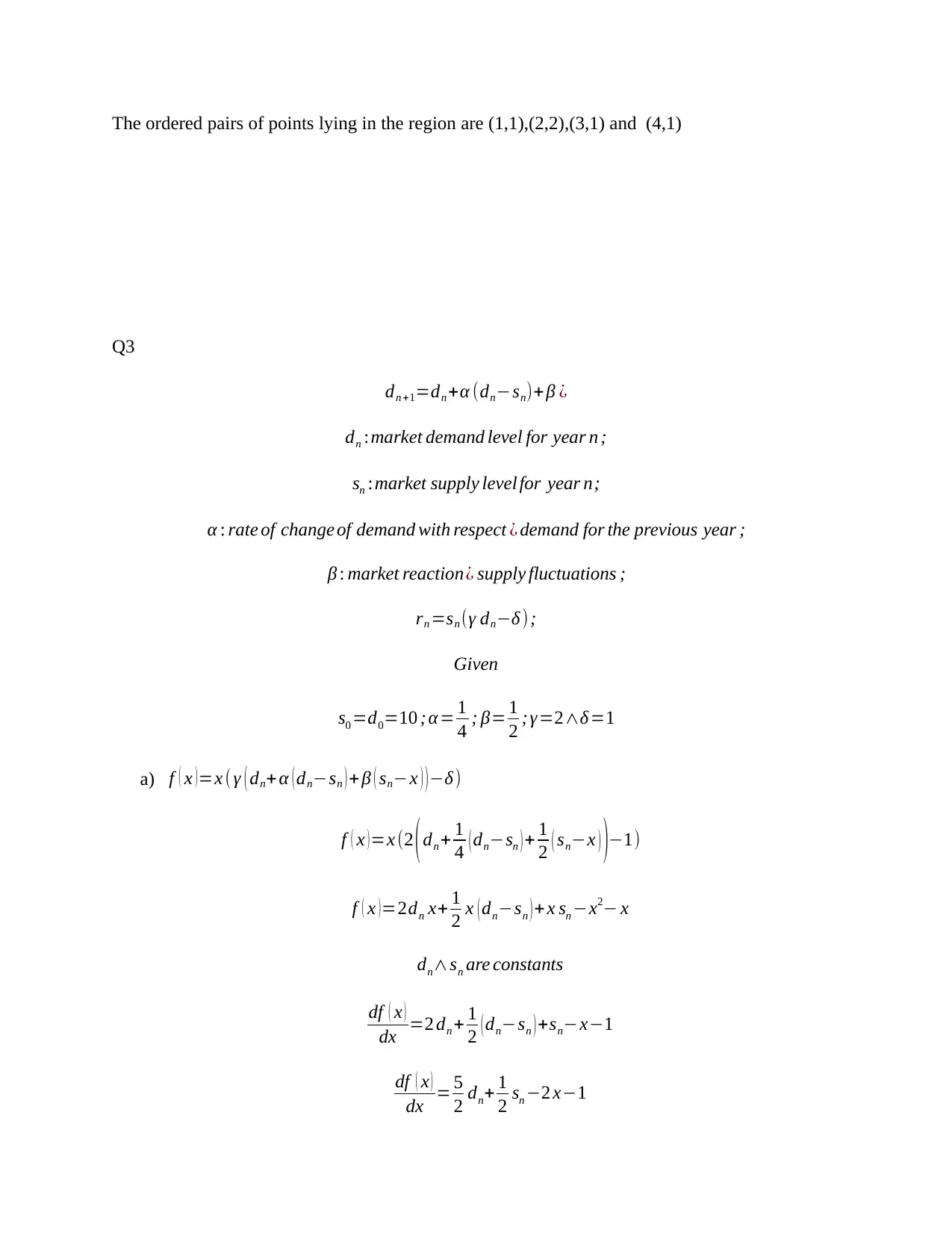
The ordered pairs of points lying in the region are (1,1),(2,2),(3,1) and (4,1)
Q3
dn +1=dn +α (dn−sn)+ β ¿
dn :market demand level for year n ;
sn :market supply level for year n;
α : rate of change of demand with respect ¿ demand for the previous year ;
β : market reaction¿ supply fluctuations ;
rn =sn (γ dn−δ );
Given
s0 =d0=10 ;α = 1
4 ; β= 1
2 ; γ=2∧δ=1
a) f ( x )=x ( γ ( dn+ α ( dn−sn ) + β ( sn−x ) )−δ)
f ( x ) =x (2 ( dn + 1
4 ( dn−sn ) + 1
2 ( sn−x ) )−1)
f ( x )=2dn x+ 1
2 x ( dn−sn ) + x sn −x2− x
dn∧sn are constants
df ( x )
dx =2 dn + 1
2 ( dn−sn ) +sn−x−1
df ( x )
dx = 5
2 dn+ 1
2 sn −2 x−1
Q3
dn +1=dn +α (dn−sn)+ β ¿
dn :market demand level for year n ;
sn :market supply level for year n;
α : rate of change of demand with respect ¿ demand for the previous year ;
β : market reaction¿ supply fluctuations ;
rn =sn (γ dn−δ );
Given
s0 =d0=10 ;α = 1
4 ; β= 1
2 ; γ=2∧δ=1
a) f ( x )=x ( γ ( dn+ α ( dn−sn ) + β ( sn−x ) )−δ)
f ( x ) =x (2 ( dn + 1
4 ( dn−sn ) + 1
2 ( sn−x ) )−1)
f ( x )=2dn x+ 1
2 x ( dn−sn ) + x sn −x2− x
dn∧sn are constants
df ( x )
dx =2 dn + 1
2 ( dn−sn ) +sn−x−1
df ( x )
dx = 5
2 dn+ 1
2 sn −2 x−1
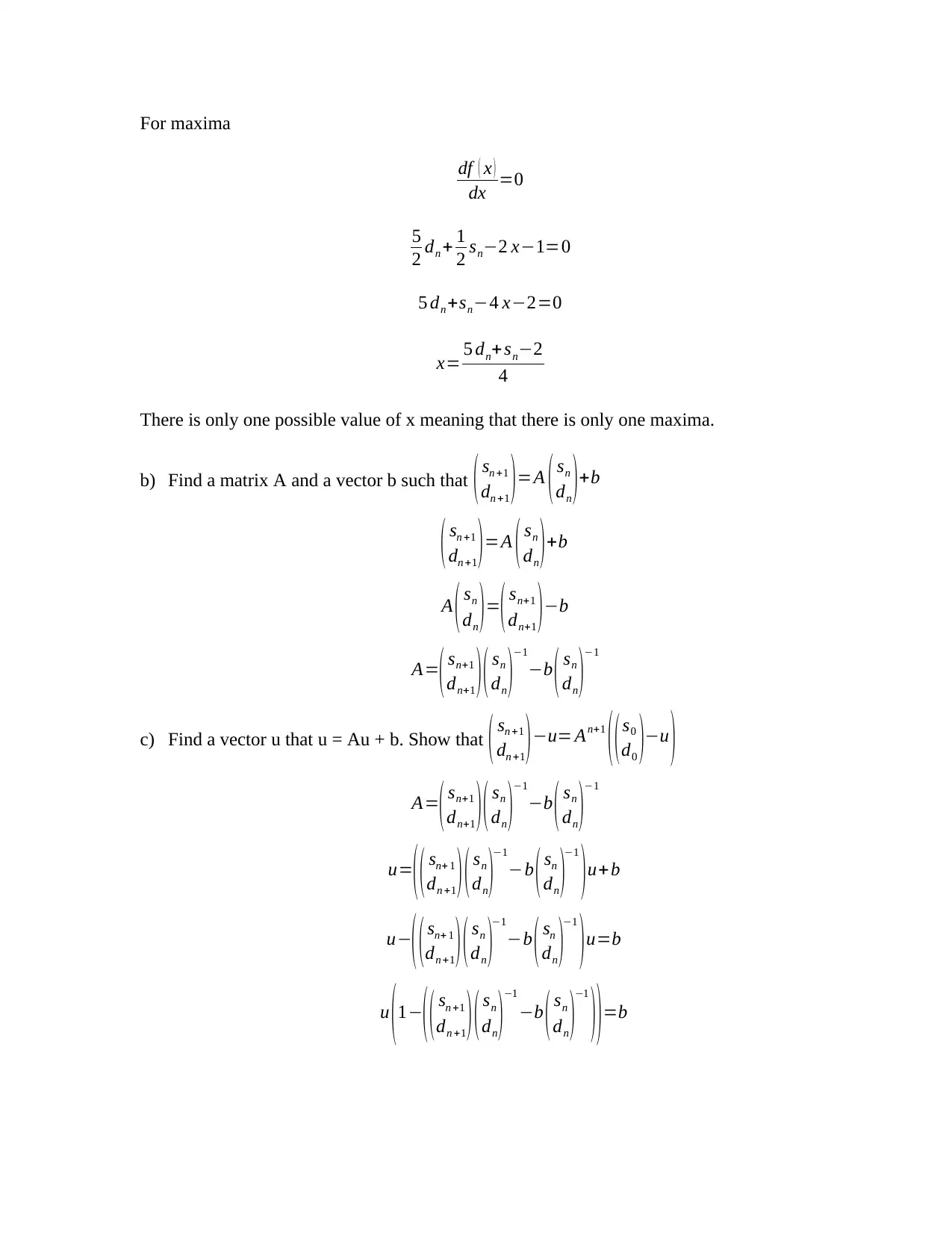
For maxima
df ( x )
dx =0
5
2 dn + 1
2 sn−2 x−1=0
5 dn +sn−4 x−2=0
x= 5 dn+ sn−2
4
There is only one possible value of x meaning that there is only one maxima.
b) Find a matrix A and a vector b such that ( sn +1
dn +1 ) =A ( sn
dn ) +b
( sn +1
dn +1 )=A ( sn
dn )+b
A ( sn
dn ) =
( sn+1
dn+1 ) −b
A=
( sn+1
dn+1 )( sn
dn )−1
−b ( sn
dn )−1
c) Find a vector u that u = Au + b. Show that ( sn +1
dn +1 )−u= An+1
( (s0
d0 )−u )
A=
( sn+1
dn+1 )( sn
dn )
−1
−b ( sn
dn )
−1
u=
( ( sn+ 1
dn +1 )( sn
dn )
−1
−b ( sn
dn )
−1
) u+ b
u−
( ( sn+ 1
dn +1 )( sn
dn )−1
−b ( sn
dn )−1
)u=b
u (1−
( ( sn +1
dn +1 )( sn
dn )−1
−b ( sn
dn )−1
))=b
df ( x )
dx =0
5
2 dn + 1
2 sn−2 x−1=0
5 dn +sn−4 x−2=0
x= 5 dn+ sn−2
4
There is only one possible value of x meaning that there is only one maxima.
b) Find a matrix A and a vector b such that ( sn +1
dn +1 ) =A ( sn
dn ) +b
( sn +1
dn +1 )=A ( sn
dn )+b
A ( sn
dn ) =
( sn+1
dn+1 ) −b
A=
( sn+1
dn+1 )( sn
dn )−1
−b ( sn
dn )−1
c) Find a vector u that u = Au + b. Show that ( sn +1
dn +1 )−u= An+1
( (s0
d0 )−u )
A=
( sn+1
dn+1 )( sn
dn )
−1
−b ( sn
dn )
−1
u=
( ( sn+ 1
dn +1 )( sn
dn )
−1
−b ( sn
dn )
−1
) u+ b
u−
( ( sn+ 1
dn +1 )( sn
dn )−1
−b ( sn
dn )−1
)u=b
u (1−
( ( sn +1
dn +1 )( sn
dn )−1
−b ( sn
dn )−1
))=b
⊘ This is a preview!⊘
Do you want full access?
Subscribe today to unlock all pages.

Trusted by 1+ million students worldwide
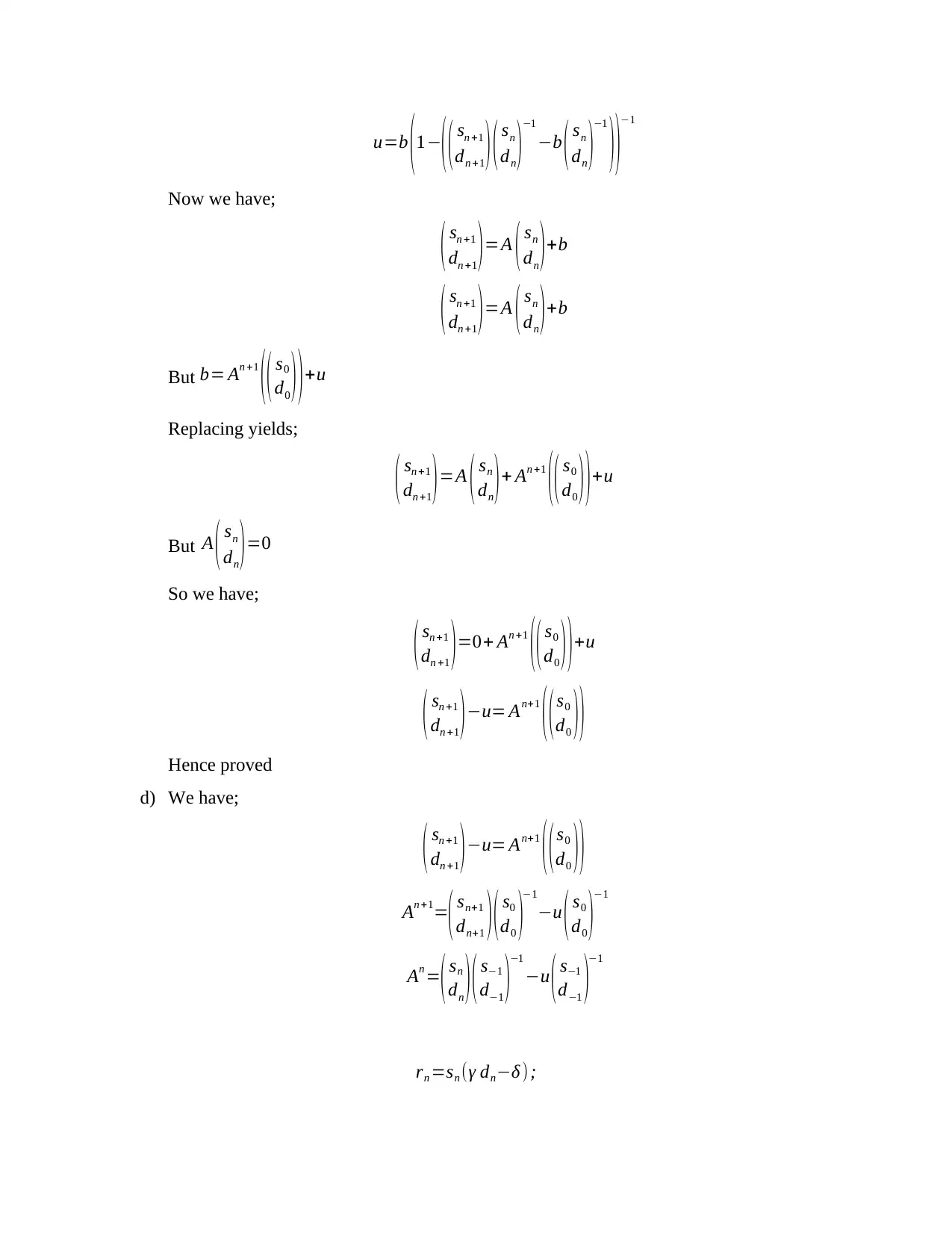
u=b ( 1−
( ( sn +1
dn +1 )( sn
dn )
−1
−b ( sn
dn )
−1
))
−1
Now we have;
( sn +1
dn +1 )=A ( sn
dn )+b
( sn +1
dn +1 ) =A ( sn
dn ) +b
But b= An +1
(( s0
d0 ) )+u
Replacing yields;
( sn +1
dn +1 )=A ( sn
dn )+ An +1
(( s0
d0 ) )+u
But A ( sn
dn )=0
So we have;
( sn +1
dn +1 )=0+ An +1
(( s0
d0 ) )+u
( sn +1
dn +1 )−u= An+1
( (s0
d0 ))
Hence proved
d) We have;
( sn +1
dn +1 )−u= An+1
( (s0
d0 ))
An +1=
( sn+1
dn+1 )( s0
d0 )
−1
−u ( s0
d0 )
−1
An =
( sn
dn )( s−1
d−1 )
−1
−u ( s−1
d−1 )
−1
rn =sn (γ dn−δ );
( ( sn +1
dn +1 )( sn
dn )
−1
−b ( sn
dn )
−1
))
−1
Now we have;
( sn +1
dn +1 )=A ( sn
dn )+b
( sn +1
dn +1 ) =A ( sn
dn ) +b
But b= An +1
(( s0
d0 ) )+u
Replacing yields;
( sn +1
dn +1 )=A ( sn
dn )+ An +1
(( s0
d0 ) )+u
But A ( sn
dn )=0
So we have;
( sn +1
dn +1 )=0+ An +1
(( s0
d0 ) )+u
( sn +1
dn +1 )−u= An+1
( (s0
d0 ))
Hence proved
d) We have;
( sn +1
dn +1 )−u= An+1
( (s0
d0 ))
An +1=
( sn+1
dn+1 )( s0
d0 )
−1
−u ( s0
d0 )
−1
An =
( sn
dn )( s−1
d−1 )
−1
−u ( s−1
d−1 )
−1
rn =sn (γ dn−δ );
Paraphrase This Document
Need a fresh take? Get an instant paraphrase of this document with our AI Paraphraser
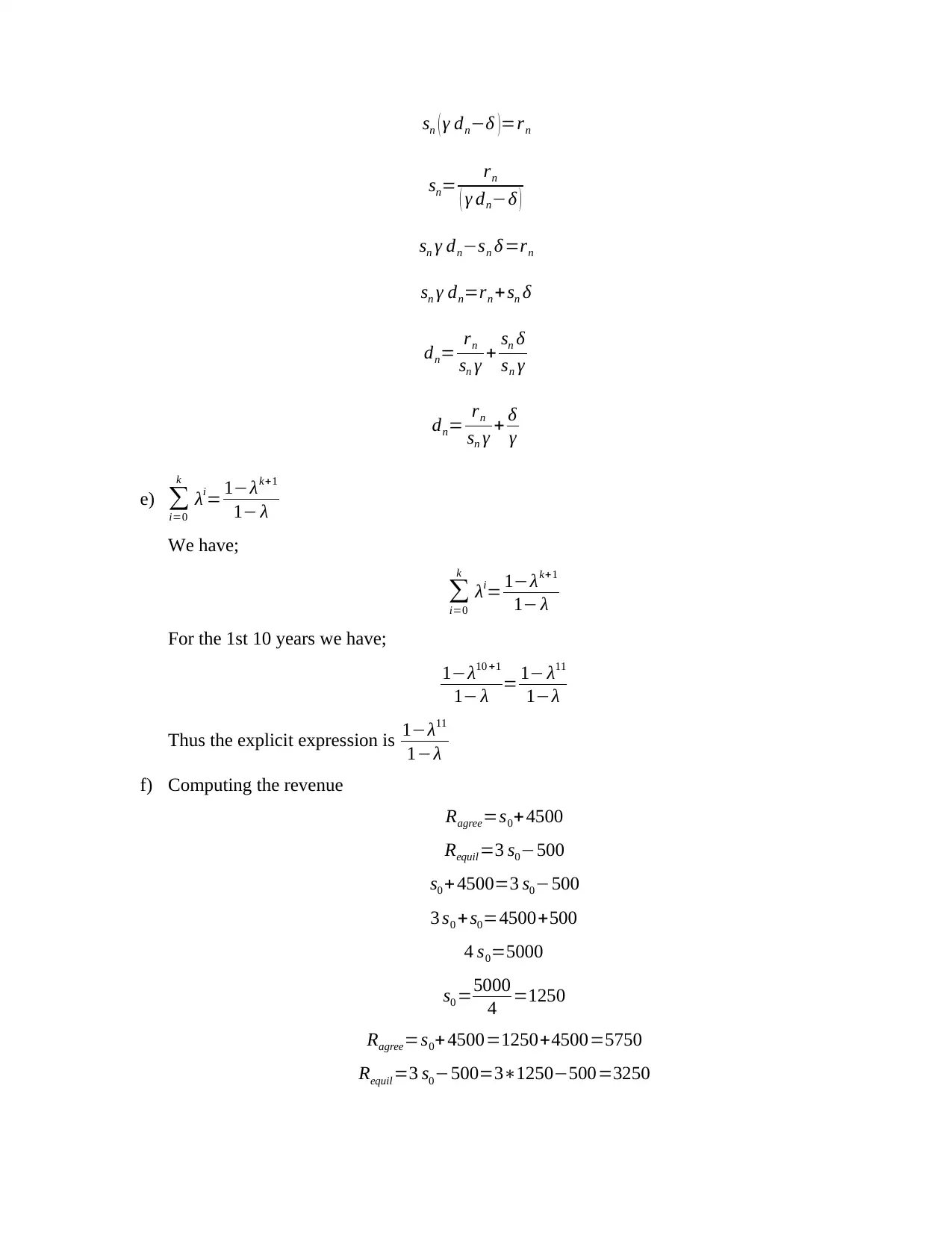
sn ( γ dn−δ )=rn
sn= rn
( γ dn−δ )
sn γ dn−sn δ=rn
sn γ dn=rn +sn δ
dn= rn
sn γ + sn δ
sn γ
dn= rn
sn γ + δ
γ
e) ∑
i=0
k
λi= 1−λk+1
1− λ
We have;
∑
i=0
k
λi= 1−λk+1
1− λ
For the 1st 10 years we have;
1−λ10 +1
1− λ = 1− λ11
1−λ
Thus the explicit expression is 1−λ11
1−λ
f) Computing the revenue
Ragree=s0+4500
Requil=3 s0−500
s0 + 4500=3 s0−500
3 s0 +s0=4500+500
4 s0=5000
s0 =5000
4 =1250
Ragree=s0+ 4500=1250+4500=5750
Requil =3 s0−500=3∗1250−500=3250
sn= rn
( γ dn−δ )
sn γ dn−sn δ=rn
sn γ dn=rn +sn δ
dn= rn
sn γ + sn δ
sn γ
dn= rn
sn γ + δ
γ
e) ∑
i=0
k
λi= 1−λk+1
1− λ
We have;
∑
i=0
k
λi= 1−λk+1
1− λ
For the 1st 10 years we have;
1−λ10 +1
1− λ = 1− λ11
1−λ
Thus the explicit expression is 1−λ11
1−λ
f) Computing the revenue
Ragree=s0+4500
Requil=3 s0−500
s0 + 4500=3 s0−500
3 s0 +s0=4500+500
4 s0=5000
s0 =5000
4 =1250
Ragree=s0+ 4500=1250+4500=5750
Requil =3 s0−500=3∗1250−500=3250
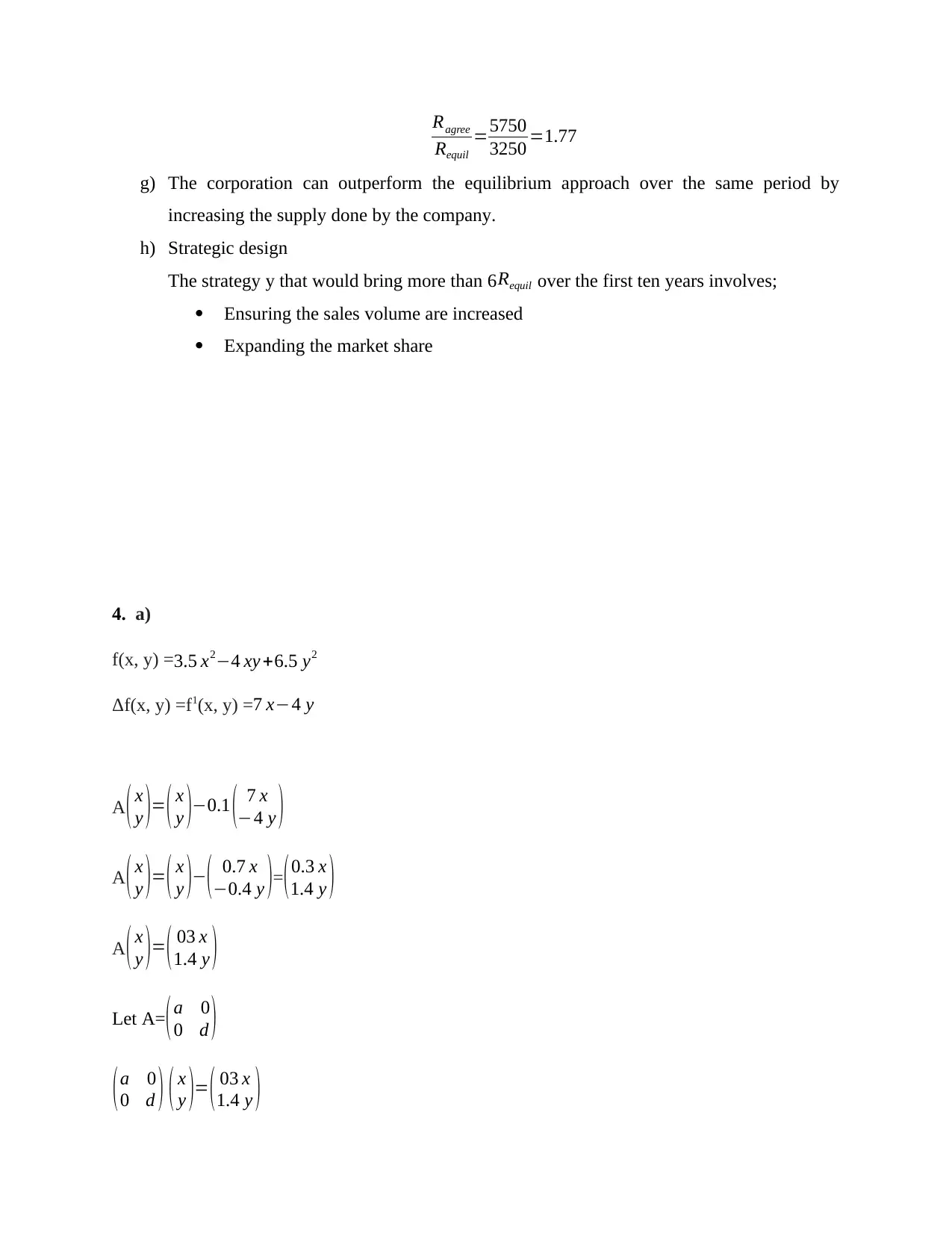
Ragree
Requil
=5750
3250 =1.77
g) The corporation can outperform the equilibrium approach over the same period by
increasing the supply done by the company.
h) Strategic design
The strategy y that would bring more than 6 Requil over the first ten years involves;
Ensuring the sales volume are increased
Expanding the market share
4. a)
f(x, y) =3.5 x2−4 xy +6.5 y2
Δf(x, y) =f1(x, y) =7 x−4 y
A( x
y )= ( x
y )−0.1 ( 7 x
−4 y )
A( x
y )= ( x
y )−( 0.7 x
−0.4 y )=( 0.3 x
1.4 y )
A( x
y )= ( 03 x
1.4 y )
Let A= ( a 0
0 d )
( a 0
0 d ) ( x
y )= ( 03 x
1.4 y )
Requil
=5750
3250 =1.77
g) The corporation can outperform the equilibrium approach over the same period by
increasing the supply done by the company.
h) Strategic design
The strategy y that would bring more than 6 Requil over the first ten years involves;
Ensuring the sales volume are increased
Expanding the market share
4. a)
f(x, y) =3.5 x2−4 xy +6.5 y2
Δf(x, y) =f1(x, y) =7 x−4 y
A( x
y )= ( x
y )−0.1 ( 7 x
−4 y )
A( x
y )= ( x
y )−( 0.7 x
−0.4 y )=( 0.3 x
1.4 y )
A( x
y )= ( 03 x
1.4 y )
Let A= ( a 0
0 d )
( a 0
0 d ) ( x
y )= ( 03 x
1.4 y )
⊘ This is a preview!⊘
Do you want full access?
Subscribe today to unlock all pages.

Trusted by 1+ million students worldwide
1 out of 17
Related Documents
Your All-in-One AI-Powered Toolkit for Academic Success.
+13062052269
info@desklib.com
Available 24*7 on WhatsApp / Email
![[object Object]](/_next/static/media/star-bottom.7253800d.svg)
Unlock your academic potential
Copyright © 2020–2025 A2Z Services. All Rights Reserved. Developed and managed by ZUCOL.





